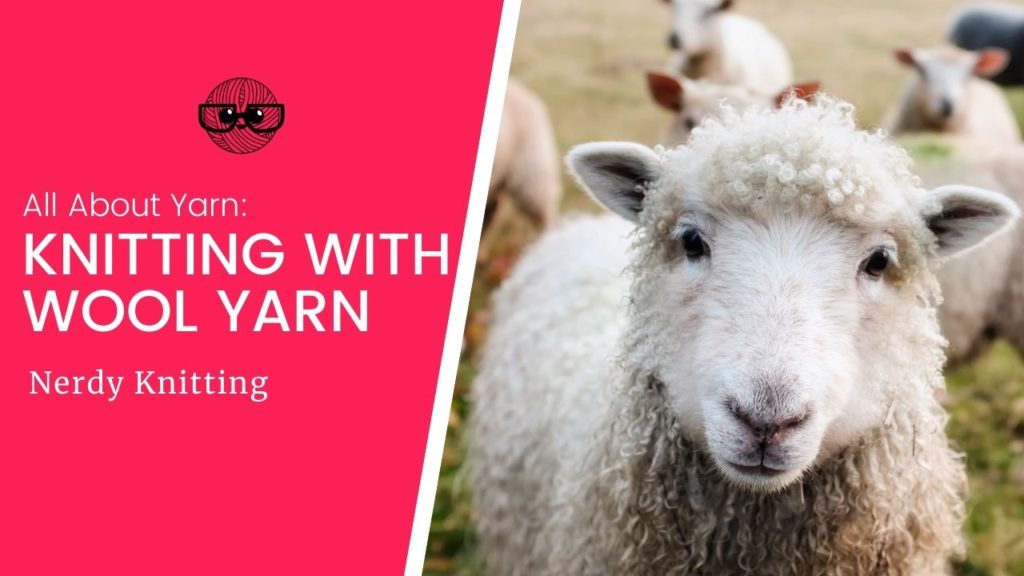Wool yarn is the perfect yarn for knitting. Sometimes knitters refer to ‘knitting wool’ – even when they mean other fibers and yarns. But, while it can be a generic term, sheep’s wool is one specific type of yarn that is used worldwide. It’s warm, lightweight, and has wonderful elasticity and memory. But, as with any type of yarn, there are a few important things that knitters should know about before they choose a wool yarn for their next project.
In this article we’ll look at all the facts about knitting wool yarn:
- Fleece into Yarn
- Properties of Wool
- Knitting with Wool Yarn
- Caring for Finished Projects
- Buying Wool Yarns
- More Questions about Wool
Let’s take a closer look at each of these areas. Then you’ll know exactly when to choose wool yarn for your next knitting project.
Some links below are affiliate links. If you click through and make a purchase I may receive a small commission at no extra cost to you. See the disclosure policy for more information.
Fleece into Yarn
All fibers for yarn can be divided into four broad categories – animal fibers (like wool, silk, and alpaca), plant fibers (like cotton and linen), biosynthetic fibers (like rayon and bamboo), and synthetic fibers (like acrylic and nylon). Wool fleece comes from sheep so wool falls into the first category of animal fibers.
Wool fleece is sheared in one large piece (with an average weight of 10 pounds per fleece) from the sheep. Each breed (there are many, many breeds) produces unique fleeces. They come in a wide variety of colors, textures, and can even feel differently when you touch them – some are quite soft and others are scratchy and coarse. Every breed produces wool with differences – though they all share some very basic properties.
For example, Merino wool comes from the Merino sheep with exceptionally long and soft coats (best used for items that will sit close to the skin). Icelandic wool, often referred to as Lopi, is a fuzzy yarn that’s spun from the fleece of Icelandic sheep. It’s often used for colorwork yoke sweaters because the scales on the fibers help the various yarns stick together. Lambswool (the first shearing of a sheep) is the warmest and softest fiber.
Today, most of the world’s commercially-available wool is now produced in Australia and New Zealand but you can find various sheep breeds all over the world.

Properties of Wool
Wool is the perfect fiber for producing garments – both woven and knit. There are so many distinct advantages that make it great for fabric and very few drawbacks. And it’s also a unique fiber.
One of the things that make this fiber source unique is its ability to felt (which can be both an advantage – when you want to felt a project; and a disadvantage – accidental felting is not a nice thing). Wool is a ‘sticky’ fiber because the scales that cover the surface of each hair like to hold the fibers together. If heat, moisture, and/or agitation are introduced (like what happens when using a washing machine – even with cold water), those scales will fuse together, felt the wool, and shrink the project permanently. This is not a reversible process.
While felting (and fulling) can be a wonderful way to produce waterproof wool garments and projects, unless you intend to felt a garment, you want to treat your wool garments gently.
Advantages of Wool
While caring for finished garments takes a little more time than just tossing them into a washing machine, the advantages of wool far outweigh the drawbacks.
Wool is:
- elastic
- has good memory
- relatively lightweight
- warm
- durable
- very good insulator
- water absorbent
- doesn’t hold odours
- wrinkle resistant
- receptive to dye
- flame-retardant
You can knit a warm sweater and go out in the rain and you’ll notice that the wool keeps you warm and dry, even as it absorbs water.
The memory and elasticity are what really make wool shine. Elasticity refers to the fibers ability to stretch – and wool will stretch. Memory refers to the fibers ability to go back to their natural state after being stretched – something else that is inherently natural for wool fibers.
This combination of elasticity and memory makes wool truly versatile. You can make garments that will stretch and move and still hold their shape (something that is clearly lacking in plant-based yarns – and often while you’ll find wool or another fiber that has some elasticity added to plant-based yarns).
One interesting thing to note is the nature of wool as a flame-retardant – and while you’ll often see fire blankets (meant for extinguishing fires safely) made from wool.
Disadvantages of Wool
While there are plenty of reasons to choose wool for your knitting projects, you’ll want to be aware of the drawbacks as well.
These include:
- Wool can be weaker when wet
- Needs to be hand washed
- Some wool yarns are more expensive
- Some wool fibers are scratchy and coarse
Because wool fibers can be weaker when they are wet, you’ll want to treat them gently when you care for your garments. Some breeds are rarer or their fleece is finer and softer so those yarns can be more expensive. And, finally, depending on the breed, some wool can be scratchy and coarse. These types of yarn are best reserved for projects that won’t be right against the skin (save the finer, softer wool and other yarns for those types of projects).
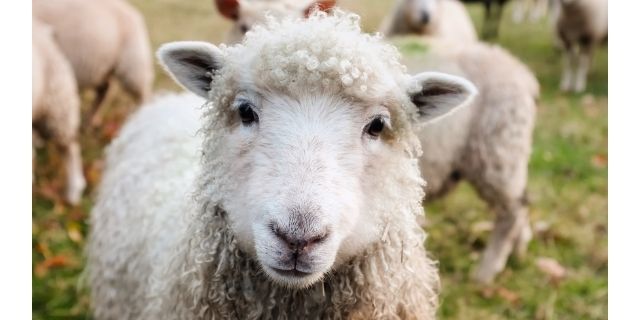
Knitting with Wool Yarn
Like we’ve stated before, every breed of wool is different – and this means they’ll feel different when you’re knitting with them as well. Some will be soft and feel wonderful. Others may feel scratchy and coarse. If you are really not enjoying a particular yarn, you can wind it into a hank and soak it in some wool wash or a small amount of hair condition to soften the fibers before winding it back into a ball and knitting.
Aside from the texture of the fibers themselves, wool is very nice to knit with because of its natural elasticity. Fibers that have no elasticity are hard to knit because they don’t have any ‘give’ as you work with them – which can cause hand pain and tension. Wool doesn’t have this problem because it has plenty of natural ‘give’ (that elasticity) that makes them easier on the hands.
Choosing Knitting Patterns
Wool is an excellent choice when it comes to knitting because it has so many wonderful advantages. It has great memory and elasticity so is the perfect choice for ribbing (which needs those traits to hold its shape), cables, and other highly textured fabrics.
It’s a good choice for warm winter garments or even for light summer garments (knit in a light yarn) because it’s a lightweight fiber as well (a plant-based fiber mixed with wool makes very nice summer tops).
Those scratchy wools are wonderful for colorwork garments (the scratchy, sticky fibers will stick together and make your colorwork simply beautiful). And, while they are great for colorwork, those scratchy fibers also retain heat and keep you warm as well.
Of course, yarns can be spun differently and that also affects how your garment will look – whether the stitches are clear and defined or more fuzzy. Two sweaters, both knit in wool, can look completely different depending on how the yarn was spun. A tightly-spun, plied wool will have clear and defined stitch definition while a soft single woolen spun yarn will be softer and even a bit hazy.
Get the Yarn Substitution Checklist
Fill in the form below to get a free copy of the Four Step Checklist for substituting yarn. Use it for your next knitting project!
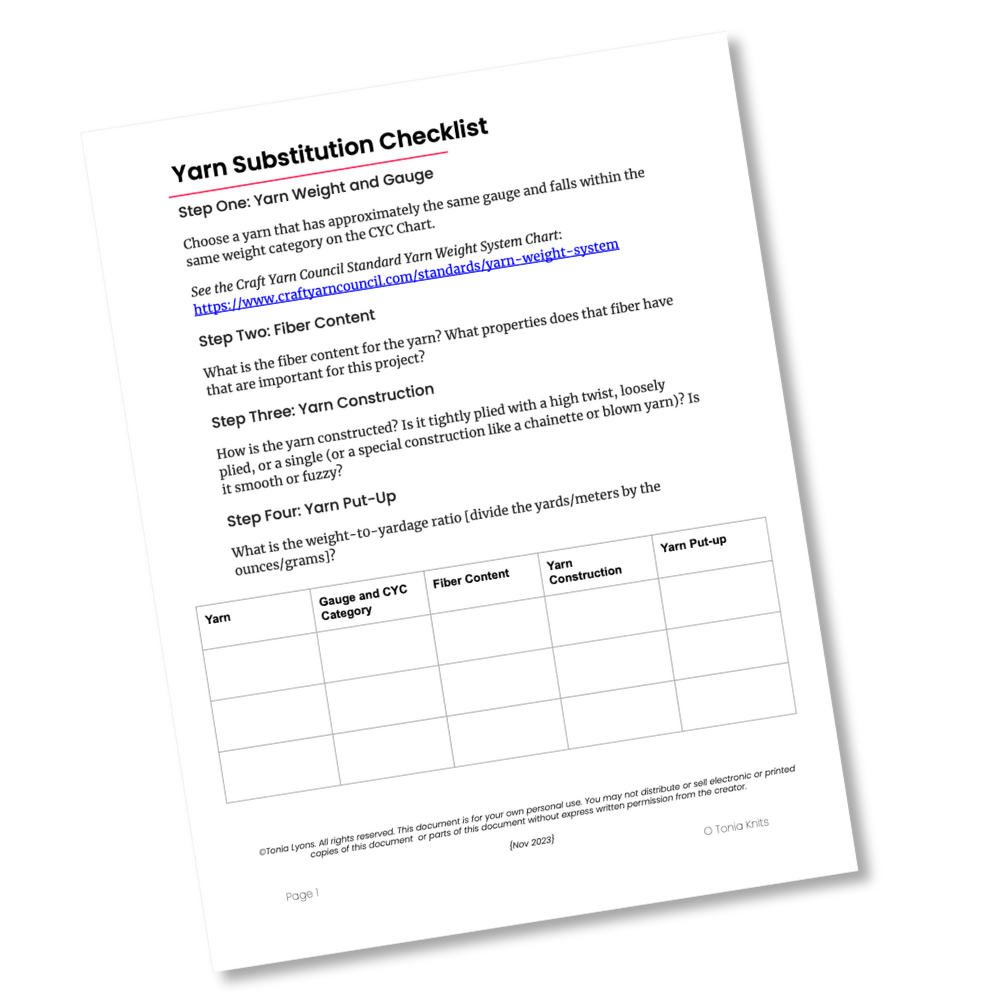
Caring for Finished Projects
Wool is a wonderful fiber for knitting, but the one reason many people don’t like it is because it usually needs to be hand washed (unless it is a superwash wool or the yarn label indicates that it can be placed in the washing machine). The scales on the fibers, when exposed to a combination of heat, moisture, and agitation, will begin to stick together. And if these conditions continues, the fibers will continue to shrink and stick together – a process known as felting.
Sometimes this is a desired outcome – if you want to felt a bag or slippers. But most of the time this isn’t the outcome you want for your finished project so you’ll have to treat your woolly knits gently.
But, on a positive note, wool doesn’t hold odours and there’s no need to wash them every time you wear them. You can even get away with washing them once part way through the winter season and then again before your winter knits are stored away for warmer weather with perhaps a quick steam to refresh them every once in awhile. But don’t store them with stains or dirt for long periods of time – that’s what attracts moths.
If your yarn is a blend and includes other fibers, be sure to read the care instructions on the yarn label for more specific guidelines. But these hand washing instructions are usually good for all types of garments.
Hand washing wool yarns: Fill a small basin with cool to lukewarm water and a little mild detergent. If it’s a particularly scratchy wool you could also add a small amount of regular hair conditioner to help soften the fibers. Submerge the garment in the liquid, carefully using your fingers to dislodge any stains. Let the garment soak for a few minutes (up to about 30 minutes, if you want).
To rinse the garment, hold it to one side of the basin as you drain the water and add fresh water. When you’re ready to dry the garment, lift it gently from the water (remember, wool is weaker when it’s wet) and carefully squeeze out the water. Place the garment on a towel, roll it up, and press out the excess water before placing it on a mesh hanger, mat, or towel to dry completely.
If your garment just needs a quick refresh, a hand-held garment steamer or a clothes iron set to medium can be used to freshen it up. Just place the garment on a flat surface and run the steamer slowly over the surface. If you’re using a clothes iron – never press the iron on the garment – just use the steam feature, holding the iron about an inch or so away from the fabric.
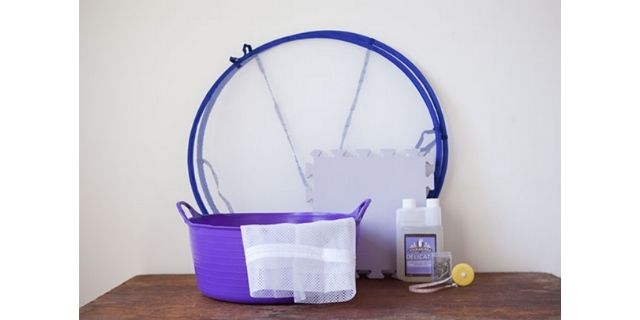
Blocking Wool Knits
Usually, hand washing and then placing the finished project on a flat surface (on a mat or towel) is all you need to do in most cases – and it could actually be considered ‘blocking’ in the broadest sense of the term. But sometimes you need to open up a lace pattern or make sure a project is finished to specific measurements. If that’s the case, you may need to do more than just lay your project flat to dry.
Wool is versatile and there are a few ways you can block your projects – all using water in one form or another.
Wet-blocking wool yarns: After washing and pressing out the excess water with a towel, place the garment on a dry towel or mesh sweater dryer and place it in its final shape, stretching any lace or other openwork designs to showcase them, pinning the garment if necessary.
Steam-blocking wool yarns: Place the garment on a towel or mat and use a steamer to relax the fibers, moving it slowly over the surface of the fabric. If you’re using a clothes iron to provide the steam – don’t press it on the garment. Instead, just hold down the steam button and hover it about an inch or so above the garment, moving the iron to cover every surface. If your project needs to be pinned before steaming, pin it out to its measurements, angling the pins outwards to allow the steamer or iron close access to the garment.
Spray-blocking wool yarns: If you have a project that is very fragile or it’s a lace project that you want to pin out before it gets wet, spray blocking may be a better choice. Place the garment on a mat or towel, adjusting it to its finished dimensions, and pinning the garment if needed. Using a spray bottle, gently mist the garment with water until it’s wet to the touch. Let it to dry completely.
Any of these methods work well with wool. Choose the best method that fits your situation (especially if other fibers are included in your yarn – those can affect the method you choose as well).
Buying Wool Yarns
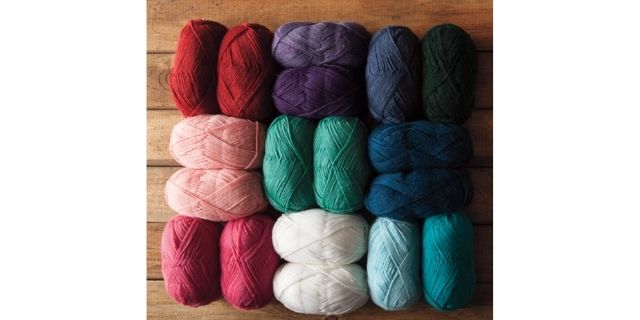
Wool can be found in so many yarns that it would be so hard to narrow them down. It’s used on its own, blended with other fibers, and comes in a variety of weights. It even comes in a ‘superwash’ version that can be machine washed without felting. Learn more about superwash wool in this article: The Facts about Knitting Superwash Wool.
You’ll often see just ‘wool’ on a yarn label but very often the breed or location of the sheep might be listed as well (you’ll often see Merino listed if that type of wool is included). And, because each breed is different (and because each yarn can be spun differently), all of these wool yarns will feel different and ‘knit up’ differently too.
Some might be soft (like Merino and lambswool) or more ‘sticky’ and scratchy like Icelandic Lopi (which is great for colorwork garments). Every wool yarn is unique and you’ll discover your favorite breeds and brands as you continue knitting.
More Questions about Wool Fiber
While we’ve discussed everything you need to know to start knitting with wool, there are some commonly asked questions that I’ve collected right here (especially for those people who are jut looking for quick answers).
Does wool shrink when washed?
Wool needs to be gently hand washed in cool or lukewarm water because the fibers will felt and the project will shrink if it is exposed to a mixture of heat, moisture, and agitation. If you wash a 100% wool garment in a washing machine, the combination of agitation and water will cause the project to felt and shrink.
Is lambswool warmer than wool?
Lambswool is the wool that comes from first shearing for every sheep. This fiber is the warmest and softest wool the sheep will ever produce.
What is the warmest wool?
Qiviut fibers (which come from the Musk Ox) is the warmest wool. It’s eight times warmer than sheep’s wool.
What is the most expensive wool?
Vicuña wool is the most expensive because of four factors. The animals are a protected species after being hunted to near extinction, they are not domesticated, they are only shorn every three years, and each animal only produces about one pound of wool at their shearing. These facts make it the most expensive wool available.
More About Yarns & Fibers
- The Knitter’s Book of Yarn by Clara Parkes (available at Amazon)
- Yarn Substitution Made Easy by Carol J. Sulcoski (available at Amazon)
- The Fleece & Fiber Sourcebook by Carol Ekarius & Deborah Robson (available at Amazon)
